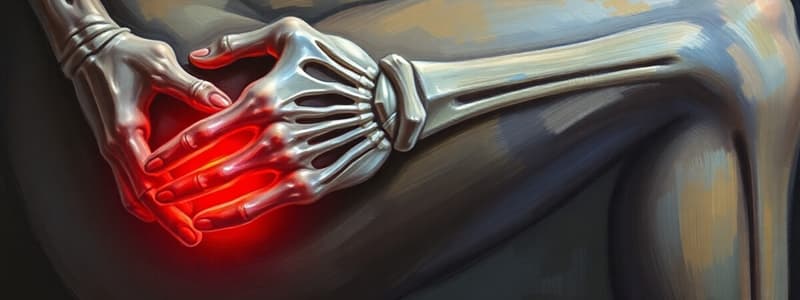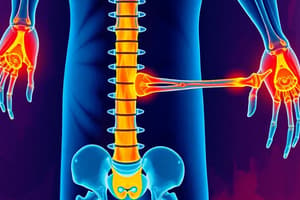Podcast
Questions and Answers
What types of joints are primarily affected by osteoarthritis?
What types of joints are primarily affected by osteoarthritis?
- Weight-bearing and those affected by autoimmune responses
- Only those in the upper body
- Weight-bearing and those subjected to repetitive motions (correct)
- Synovial and cartilaginous joints
Which characteristic distinguishes osteoarthritis from rheumatoid arthritis?
Which characteristic distinguishes osteoarthritis from rheumatoid arthritis?
- Rheumatoid arthritis primarily affects the elderly
- Rheumatoid arthritis causes joint replacement surgery
- Osteoarthritis is not inflammatory in nature (correct)
- Osteoarthritis has chronic inflammation in joints
What is a common outcome of osteoarthritis in terms of patient mobility?
What is a common outcome of osteoarthritis in terms of patient mobility?
- Diminished quality of life due to pain (correct)
- Ability to walk long distances
- Sudden onset of joint pain
- Complete loss of joint function
Which of the following is NOT a common treatment option for osteoarthritis?
Which of the following is NOT a common treatment option for osteoarthritis?
What diagnostic tools are typically utilized for osteoarthritis?
What diagnostic tools are typically utilized for osteoarthritis?
Which finding is expected in radiographic imaging of osteoarthritis?
Which finding is expected in radiographic imaging of osteoarthritis?
What is a significant risk factor for developing osteoarthritis?
What is a significant risk factor for developing osteoarthritis?
What is a known secondary effect of corticosteroids in the treatment of osteoarthritis?
What is a known secondary effect of corticosteroids in the treatment of osteoarthritis?
Which type of arthritis has a specific age onset range of 3-6 years?
Which type of arthritis has a specific age onset range of 3-6 years?
What is the leading cause of joint replacement surgery?
What is the leading cause of joint replacement surgery?
What is the primary first-line treatment for osteoporosis?
What is the primary first-line treatment for osteoporosis?
Which group is at the highest risk for developing osteoporosis?
Which group is at the highest risk for developing osteoporosis?
What lifestyle factor is NOT associated with an increased risk of osteoporosis?
What lifestyle factor is NOT associated with an increased risk of osteoporosis?
What is the typical diagnostic approach for fibromyalgia?
What is the typical diagnostic approach for fibromyalgia?
In fibromyalgia, which symptom is considered dominating?
In fibromyalgia, which symptom is considered dominating?
Which medication is commonly used to treat pain associated with fibromyalgia?
Which medication is commonly used to treat pain associated with fibromyalgia?
What is a common ocular manifestation seen in ankylosing spondylitis?
What is a common ocular manifestation seen in ankylosing spondylitis?
Which demographic is predominantly affected by ankylosing spondylitis?
Which demographic is predominantly affected by ankylosing spondylitis?
What is the impact of estrogen decrease during menopause on osteoporosis risk?
What is the impact of estrogen decrease during menopause on osteoporosis risk?
What is a key characteristic of fibromyalgia diagnosed following diagnostic measures?
What is a key characteristic of fibromyalgia diagnosed following diagnostic measures?
What is a common characteristic symptom of uveitis?
What is a common characteristic symptom of uveitis?
Which feature is NOT typically associated with inflammatory back pain?
Which feature is NOT typically associated with inflammatory back pain?
What is a common pharmacologic treatment for uveitis?
What is a common pharmacologic treatment for uveitis?
Which test is NOT useful for confirming a diagnosis of gout?
Which test is NOT useful for confirming a diagnosis of gout?
In ankylosing spondylitis, which demographic feature is most commonly noted?
In ankylosing spondylitis, which demographic feature is most commonly noted?
Which symptom is indicative of chronic gout?
Which symptom is indicative of chronic gout?
What is the major mechanism causing hyperuricemia in most gout cases?
What is the major mechanism causing hyperuricemia in most gout cases?
Which of the following medications is commonly used as long-term management for gout?
Which of the following medications is commonly used as long-term management for gout?
What complication is commonly associated with uveitis in patients with ankylosing spondylitis?
What complication is commonly associated with uveitis in patients with ankylosing spondylitis?
During an acute gout attack, which laboratory finding is likely to be observed?
During an acute gout attack, which laboratory finding is likely to be observed?
Flashcards
Osteoarthritis
Osteoarthritis
A common type of arthritis characterized by the progressive loss of cartilage and bone remodeling in weight-bearing or repetitive motion joints.
Osteoarthritis vs. Rheumatoid Arthritis
Osteoarthritis vs. Rheumatoid Arthritis
Osteoarthritis is a degenerative condition, not autoimmune, while rheumatoid arthritis is an autoimmune disease marked by chronic joint inflammation.
Risk Factors for Osteoarthritis
Risk Factors for Osteoarthritis
Obesity and repetitive stress on joints can increase osteoarthritis risk.
Osteoarthritis Symptoms
Osteoarthritis Symptoms
Signup and view all the flashcards
Osteoarthritis Diagnosis
Osteoarthritis Diagnosis
Signup and view all the flashcards
Osteoporosis
Osteoporosis
Signup and view all the flashcards
Osteoporosis Symptoms
Osteoporosis Symptoms
Signup and view all the flashcards
Osteophytes
Osteophytes
Signup and view all the flashcards
Joint Space Narrowing
Joint Space Narrowing
Signup and view all the flashcards
Non-pharmacological treatment
Non-pharmacological treatment
Signup and view all the flashcards
Osteoporosis Risk Factors
Osteoporosis Risk Factors
Signup and view all the flashcards
Osteoporosis Treatment (First Line)
Osteoporosis Treatment (First Line)
Signup and view all the flashcards
Fibromyalgia Characteristics
Fibromyalgia Characteristics
Signup and view all the flashcards
Fibromyalgia Diagnosis
Fibromyalgia Diagnosis
Signup and view all the flashcards
Fibromyalgia Treatment Principles
Fibromyalgia Treatment Principles
Signup and view all the flashcards
Ankylosing Spondylitis
Ankylosing Spondylitis
Signup and view all the flashcards
Ankylosing Spondylitis HLA B27
Ankylosing Spondylitis HLA B27
Signup and view all the flashcards
Ankylosing Spondylitis Symptoms
Ankylosing Spondylitis Symptoms
Signup and view all the flashcards
Vitamin D and Calcium
Vitamin D and Calcium
Signup and view all the flashcards
Central Sensitive Syndromes
Central Sensitive Syndromes
Signup and view all the flashcards
Ankylosing Spondylitis (AS)
Ankylosing Spondylitis (AS)
Signup and view all the flashcards
AS Symptoms
AS Symptoms
Signup and view all the flashcards
AS Diagnosis
AS Diagnosis
Signup and view all the flashcards
Gout
Gout
Signup and view all the flashcards
Acute Gout Attack
Acute Gout Attack
Signup and view all the flashcards
Chronic Gout
Chronic Gout
Signup and view all the flashcards
Gout Diagnosis
Gout Diagnosis
Signup and view all the flashcards
Uric Acid
Uric Acid
Signup and view all the flashcards
Gout Treatment (Acute)
Gout Treatment (Acute)
Signup and view all the flashcards
Gout Treatment (Long-term)
Gout Treatment (Long-term)
Signup and view all the flashcards
Study Notes
Osteoarthritis
- Typically affects weight-bearing joints and those experiencing repetitive motions
- Characterized by progressive loss of articular cartilage and bone remodeling
- Most common type of arthritis, especially in elderly patients
- Rheumatoid arthritis (RA) is an autoimmune disease, unlike osteoarthritis, which is not
- Other types of arthritis include gout and psoriatic arthritis
Osteoarthritis Causes
- Progressive loss of articular cartilage
- Inflammatory and autoimmune responses of chondrocytes in the articular cartilage, causing degradation of cartilage and bone remodeling
- Leads to developing osteophytes (bone spurs)
- Inflammation in surrounding tissue
- Release of enzymes that break down collagen and proteoglycans (important components of cartilage)
- Contributing factors include age, obesity, and joint injury
Osteoarthritis Symptoms
- Joint pain, often worse with activity and improving with rest
- Stiffness, especially after inactivity.
- Joint swelling
- Limited range of motion
- Discomfort in weight-bearing joints and during repetitive motions
Osteoarthritis, Pathophysiology
- Involves degradation of cartilage and bone remodeling due to an active response of chondrocytes in the articular cartilage
- Initial appearance of cartilaginous bone spurs (osteophytes)
- Cartilage degradation results in changes in consistency
- Inflammatory cells release enzymes, degrading collagen, and destroying articular cartilage
Osteoarthritis, Diagnosis and Treatment
- Primarily based on physical exam and patient history, rather than specific tests
- Imaging (radiographs) might reveal joint space narrowing, osteophytes, and subchondral bone cysts
- Treatment focuses on pain management, and minimizing further cartilage damage
- Physical therapy, weight reduction, and bracing are often helpful.
Additional Considerations
- Increased prevalence with age
- Disability, decreased quality of life in older patients
- Leading cause of joint replacement surgery
- Can occur before age 50
Additional Joint Types of Arthritis
- Juvenile Arthritis
- Gout (caused by elevated uric acid levels)
- Psoriatic Arthritis
- Ankylosing Spondylitis (inflammation of spine)
- Rheumatoid Arthritis (RA) (autoimmune)
Spine
- Cervical and lumbar spine frequently show degenerative disk disease, common in those over 45 years of age.
- Can be asymptomatic.
- Can induce pain in the neck, head, and down the arm, with weakness or paresthesia due to nerve compression from osteophytes.
Diagnostic Imaging
- Typically shows osteophytes (reduction of joint space), joint space narrowing, sclerosis of subchondral bone, and cysts.
- Radionuclide bone scans and MRIs are not usually needed for diagnosis
Treatment
- Non-pharmacologic methods, such as weight reduction, physical therapy, and orthotics (braces).
- Pharmacologic medications may include analgesics (acetaminophen) and anti-inflammatory drugs (NSAIDs).
- Viscosupplementation, steroid injections, or surgery may be necessary.
Osteoporosis
- Decreased bone density, often due to aging and prolonged periods of inactivity
- Elevated risk of fractures, especially hip, wrist, and spine fractures.
- Contributing factors include hormonal changes (e.g. menopause) and decreased physical activity.
Gout
- Inflammatory arthritis, usually related to high uric acid levels in the blood
- Characterized by sudden, painful episodes of swelling and inflammation in joints. The big toe joint is most common.
Ankylosing Spondylitis
- Chronic inflammatory condition affecting the spine and often other joints
- Usually involves stiffness in the spine, back pain, and often progresses to fusing of the spine's bones over time.
Fibromyalgia
- Chronic condition characterized by widespread pain, fatigue, and other symptoms
- It is not a disorder of the joints, but one of the nerve's response to pain.
- Diagnosis is based on patient history and physical exam.
Studying That Suits You
Use AI to generate personalized quizzes and flashcards to suit your learning preferences.
Related Documents
Description
This quiz provides an overview of osteoarthritis, including its causes, symptoms, and distinctions from other types of arthritis such as rheumatoid arthritis. It explores the mechanisms behind cartilage degeneration and the role of inflammation in joint pain. Perfect for anyone looking to understand this common condition.





